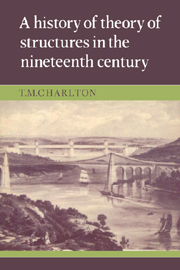Book contents
- Frontmatter
- Contents
- Preface
- 1 Introduction
- 2 Beam systems
- 3 Theory of the arch and suspension bridge
- 4 Elementary theory of frameworks: graphical statics
- 5 Theory of statically-indeterminate frameworks: the reciprocal theorem
- 6 Levy's theory of frameworks and bridge girders
- 7 Early developments of energy principles relating to theory of structures
- 8 The later development and use of energy principles
- 9 Applications of the least work principle: elastic theory of suspension bridges
- 10 Aspects of the further development of theory of structures
- 11 Secondary effects in structures
- Appendices
- Bibliography
- Name index
- Subject index
4 - Elementary theory of frameworks: graphical statics
Published online by Cambridge University Press: 18 September 2009
- Frontmatter
- Contents
- Preface
- 1 Introduction
- 2 Beam systems
- 3 Theory of the arch and suspension bridge
- 4 Elementary theory of frameworks: graphical statics
- 5 Theory of statically-indeterminate frameworks: the reciprocal theorem
- 6 Levy's theory of frameworks and bridge girders
- 7 Early developments of energy principles relating to theory of structures
- 8 The later development and use of energy principles
- 9 Applications of the least work principle: elastic theory of suspension bridges
- 10 Aspects of the further development of theory of structures
- 11 Secondary effects in structures
- Appendices
- Bibliography
- Name index
- Subject index
Summary
Bar frameworks for bridges and roofs, with timber as the material of construction, are of ancient origin. Indeed, the illustrations of such structures in early nineteenth-century works on theory of structures, for example Navier's Leçons (1826), include them within the scope of carpentry, and pictorial illustrations clearly indicate timberwork. The widespread adoption of iron framework for roof trusses, arches and bridge girders, coincided with the construction of railways (a direct consequence of the new iron age) and an urgent need for numerous bridges and large buildings. The first major iron lattice girder bridges as an alternative to solid and plate girders (by virtue of the economy afforded by reduction in self-weight) appeared, it is believed, soon after 1840. Dempsey (1864) gives an interesting account of the history of cast and wrought iron construction, noting that the first iron vessels (boats) were made in 1820–1 by Manby of Tipton. He believed that the rolled ‘I’ section was introduced by Kennedy and Vernon of Liverpool in 1844, angle section being of earlier origin, and that Fairbairn made plate girders as long ago as 1832.
Dempsey credits Smart with the invention of the diagonal lattice girder, referred to as the ‘patent iron bridge’, in 1824 but seems to believe that it was first used for a major railway bridge after 1840, on the Dublin and Drogheda Railway. That bridge was described by Hemans (1844).
- Type
- Chapter
- Information
- Publisher: Cambridge University PressPrint publication year: 1982

